Transforming your outdoor spaces into cozy, inviting areas doesn’t have to be complicated or expensive. With a few thoughtful additions and design choices, you can create the perfect place to relax or entertain. Here are some creative ideas to get you started.
1. Add a Porch Swing
A porch swing is a classic addition that instantly creates a relaxing atmosphere. Architect and homeowner Erica Broberg Smith calls her porch swing “the best seat not in the house.” To maximize comfort, add plush cushions and throw pillows. Hang the swing from sturdy chains or ropes, making sure it’s securely fastened to support beams.
2. Try a Stone Floor
Natural stone flooring can add a grounded, organic feel to your outdoor space. Irregular bluestone is a great choice for creating a seamless transition between your porch and the surrounding landscape. When installing stone on a new porch, prioritize proper drainage. For existing concrete surfaces, lay thin stone veneer for a similar effect without the need for major construction. Stone floors stay cooler underfoot on hot days.
3. Punch Up With Paint
A splash of vibrant color can breathe new life into your outdoor space. Paint wood trim or your front door in a bold hue that complements your home’s exterior and natural surroundings. For example, a fresh coat of green paint on columns and window frames can echo the leafy environment. Use exterior-grade paint for durability against the elements.
4. Keep It Casual
Creating a laid-back atmosphere in your outdoor room can make it more inviting and versatile. Incorporate rustic elements like painted wicker furniture, wrought-iron lighting fixtures, and natural decorative accents such as antlers or driftwood. These touches add character and create a sense of relaxed luxury that encourages guests to unwind and stay awhile.
5. Set Out a Sofa
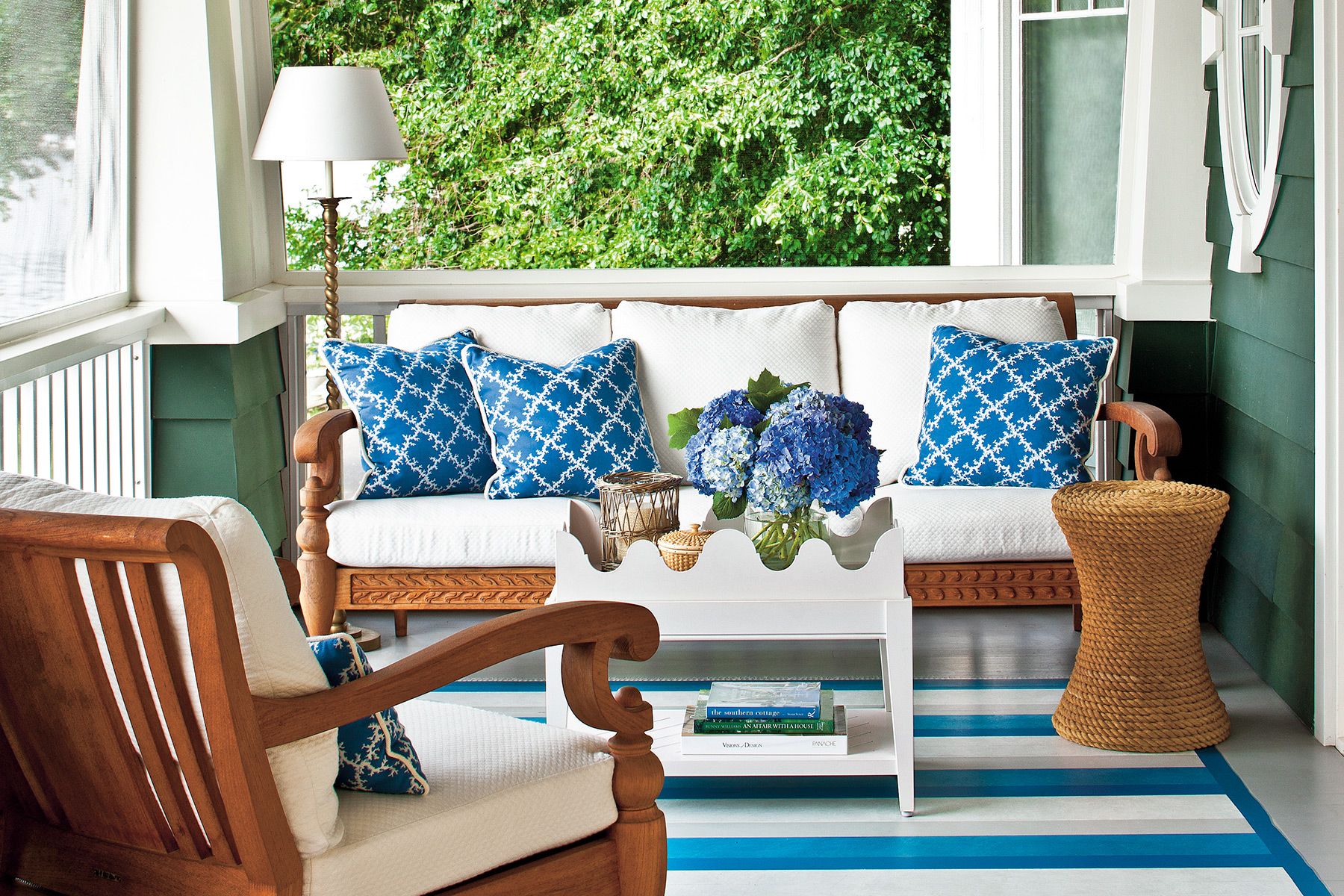
Transform your porch into an outdoor living room by adding comfortable, spacious seating. A weather-resistant sofa can serve as the centerpiece, providing ample seating for family and guests. Interior designer Kelley Proxmire chose a three-seater made with all-weather wood for this blue-and-white themed porch, creating a cozy spot to relax and enjoy the surrounding nature. Sofas with removable, washable covers make maintenance easy and extend furniture life.
6. Add a Breeze
Installing a ceiling fan designed for outdoor use can improve comfort on hot days. Not only does it help circulate air, but it can also deter insects. When selecting a fan, think about factors such as blade span, motor quality, and weather resistance. Fans with varying speeds and light fixtures add versatility and ambiance.
7. Plug in a Floor Lamp
An all-weather floor lamp can add both functional lighting and a touch of indoor sophistication to your outdoor room. Look for lamps designed for outdoor use with weather-resistant materials and sealed electrical components. Position the lamp near seating areas to create a cozy reading nook or to illuminate evening conversations. Pair with lower lighting, like lanterns or string lights, for layered illumination.
8. Paint a Permanent Rug
Instead of using traditional outdoor rugs that can be difficult to clean and maintain, paint a “rug” directly onto your porch or patio floor. This creative solution defines seating or dining areas while adding a pop of color and pattern that can withstand the elements. Use exterior-grade paint and sealers to achieve durability. You can refresh or update the design whenever desired.
9. Frame the View
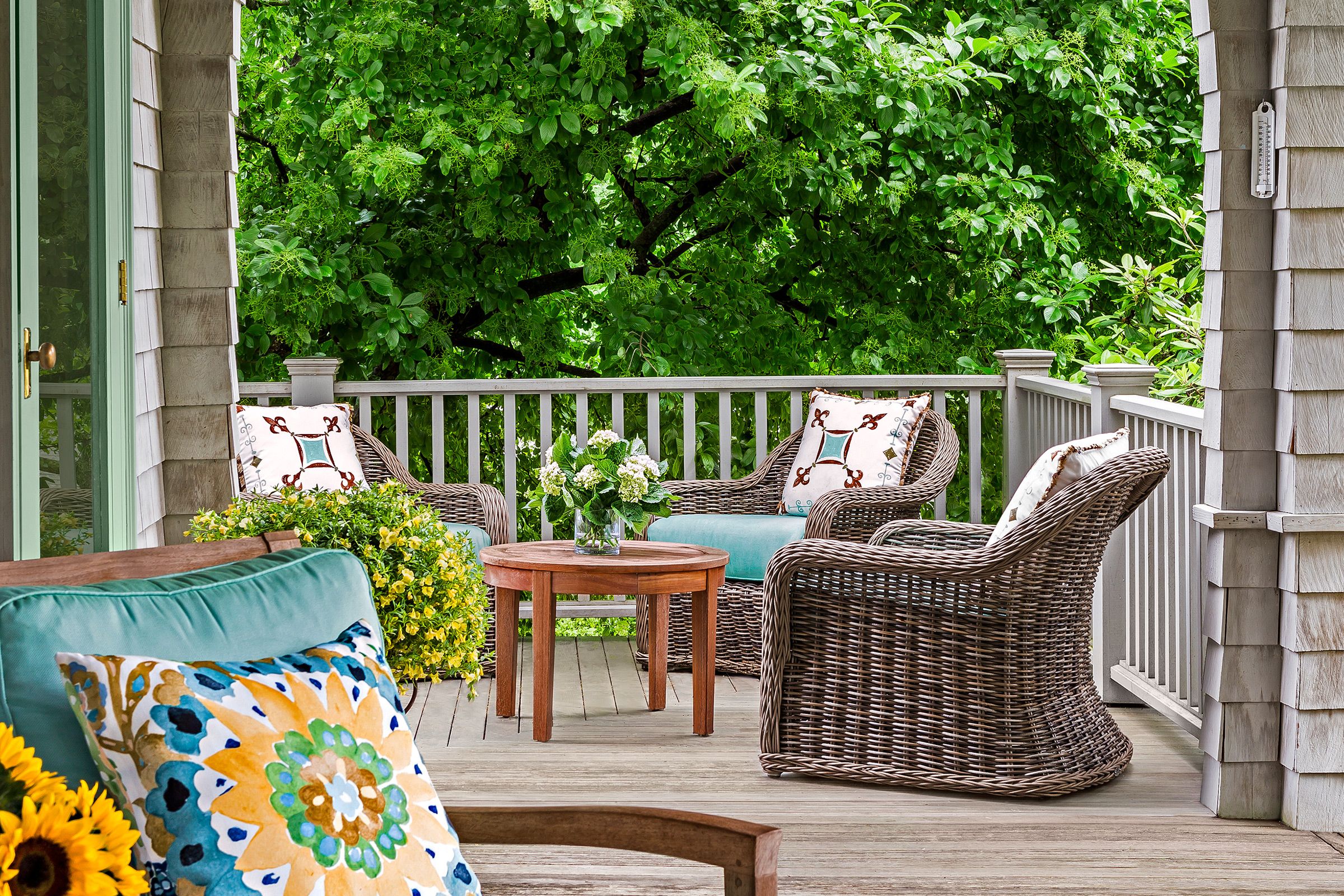
Architectural elements can improve the transition between indoor and outdoor spaces while framing picturesque views. A shapely shingled arch, as shown in the above image, creates an elegant gateway between an existing porch and a deck extension. Adding decorative brackets between porch posts and the ceiling can achieve a similar effect, defining the space and drawing the eye outward.
10. Try Classic, All-Weather Furniture
When selecting furniture for open-air spaces, durability is key. Choose pieces made from materials that can withstand sun, rain, and temperature fluctuations. Resin wicker chairs with a traditional rolled-arm design offer a classic look with modern weather resistance. Pair them with weather-resistant cushions in fade-resistant fabrics to maintain a fresh appearance throughout the seasons.
11. Add a Nautical Accent
Incorporate maritime-inspired lighting to infuse your outdoor space with coastal charm. Onion lights, reminiscent of those used on 19th-century fishing boats, provide both character and functional illumination. Available in various styles, including ceiling-mount fixtures, sconces, and post lights, these versatile pieces can complement a range of outdoor design themes. Nautical elements can work equally well in coastal and inland settings.
12. Set Up a Daybed
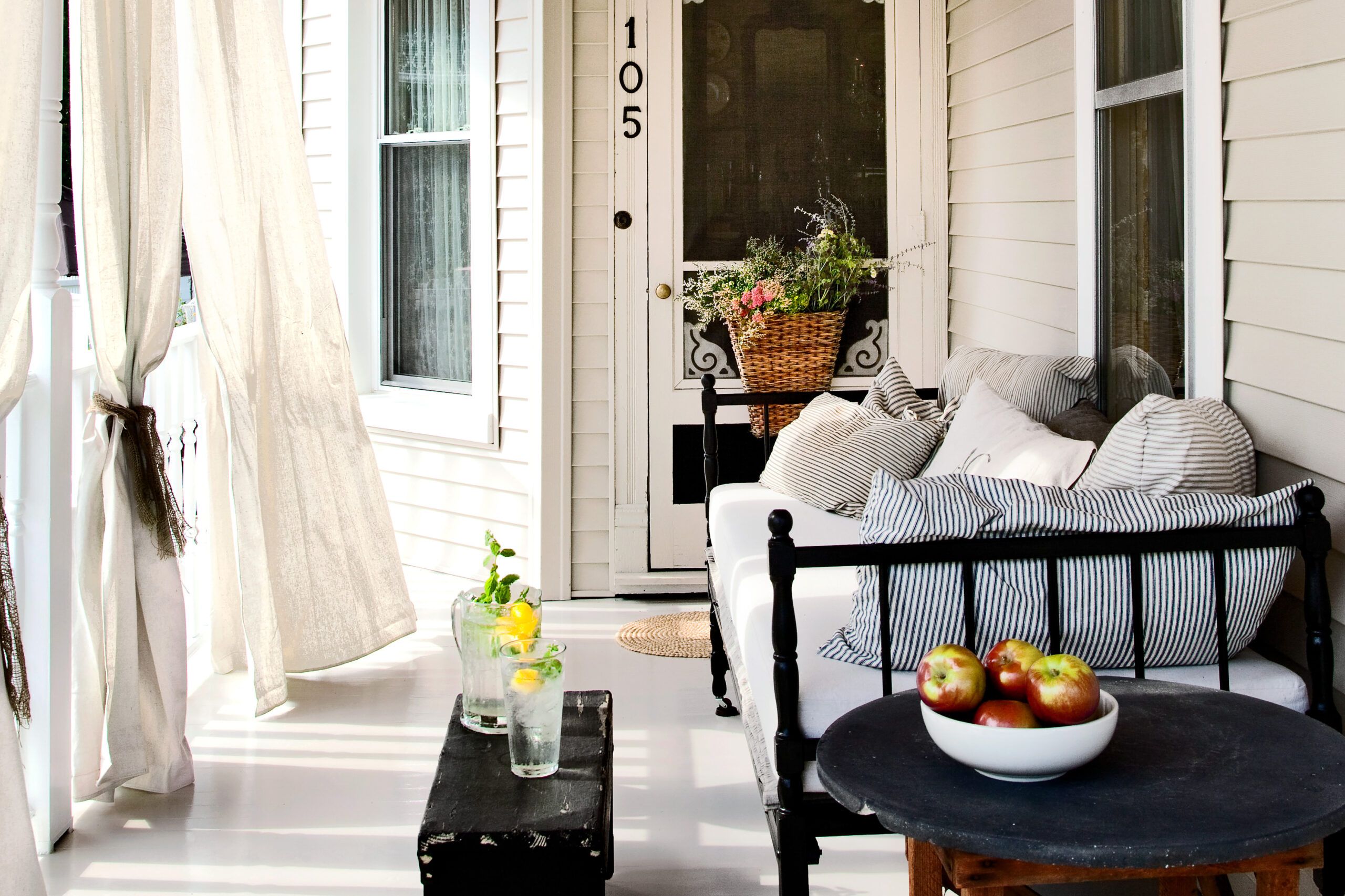
Create a cozy sleeping porch by incorporating a daybed or cot into your outdoor room. Homeowner and designer Joy Waltmire repurposed a vintage bed frame, demonstrating how creativity can transform found objects into charming focal points. To protect bedding from the elements, use a waterproof vinyl cover over the mattress and opt for weather-resistant fabrics for pillows and throws. Daybeds can serve as seating during the day and transform into nap zones by night.
13. Hang Drapes
Outdoor drapes can add a sense of luxury and privacy to your porch or patio. Long panels suspended between porch posts create a more intimate atmosphere and provide protection from sun and wind. Choose fabrics specifically designed for outdoor use for more longevity and easy maintenance. Install a retractable system for added flexibility in controlling light and privacy. Drapes can also contribute to reducing outdoor noise levels.
14. Show Off the Ceiling
The ceiling of your outdoor room offers an often-overlooked opportunity for design impact. While blue and white are traditional choices, you can also leave wood-slat or beadboard ceilings natural, protected only by clear polyurethane. This approach highlights the warmth of the wood grain and can create a beautiful contrast with white walls or columns. This contrast adds a rustic or coastal charm to your space.
15. Mix Up the Furnishings
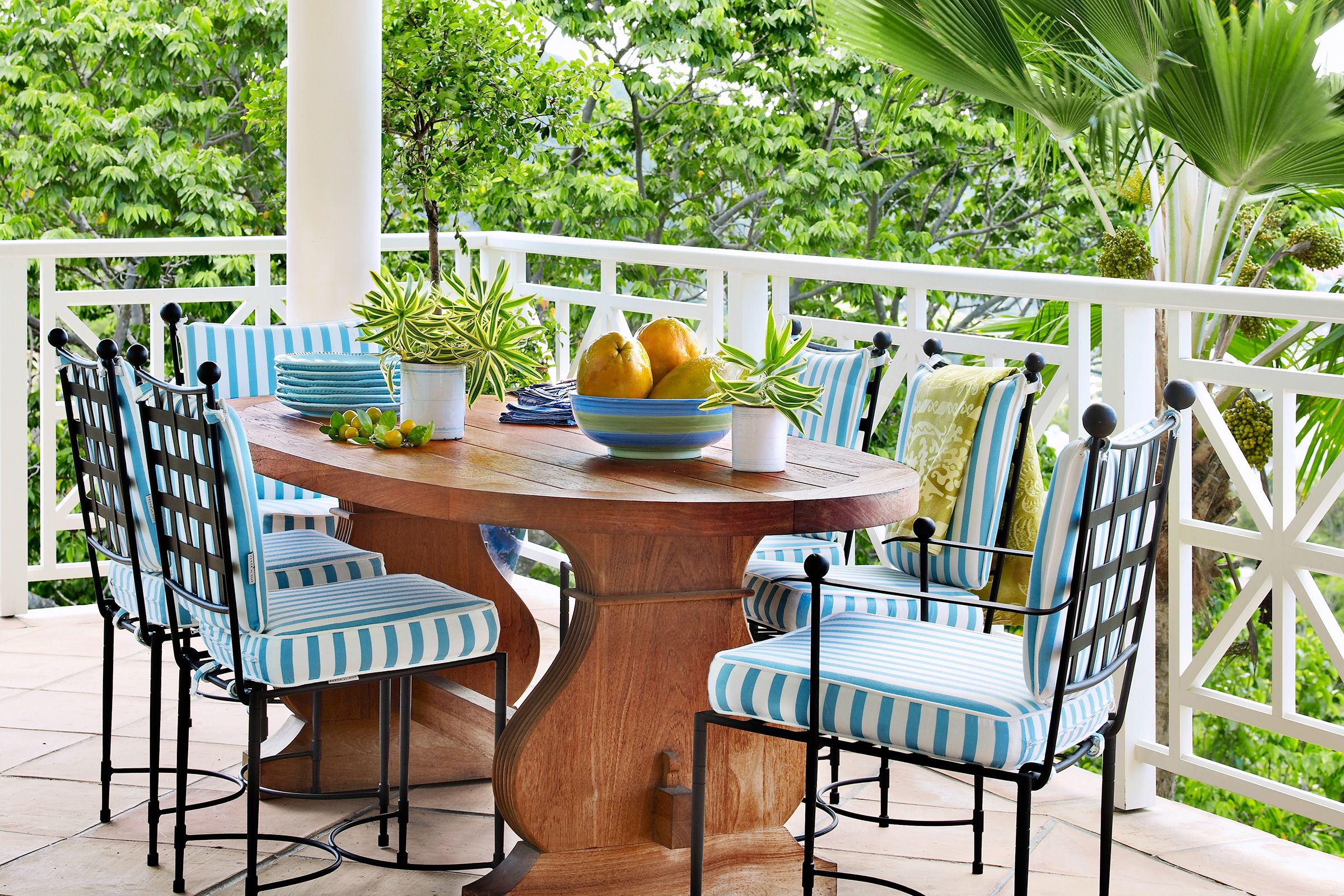
Using an eclectic mix of furniture styles can add visual interest and personality to your outdoor room. Interior designer Barry Dixon paired sleek, woven-back metal chairs with a substantial oak trestle table to create a balanced, inviting dining area that feels curated rather than matched. Eclectic combinations can make your space feel one-of-a-kind and conversational.
16. Go for Bold Textiles
Introduce color and pattern to your outdoor space through textiles. Cushions, tablecloths, and other soft furnishings offer an easy and affordable way to update your decor seasonally or as your tastes change. In this neutral setting, vibrant striped awnings and chair cushions create a lively, beachy atmosphere. Choose fabrics designed for outdoor use to maintain their appearance despite exposure to sun and moisture. Bold textiles can express your personality and rejuvenate your space.
17. Illuminate the Easy Way
A simple hanging candle lantern provides a soft, flickering light without the need for electrical wiring. A Moroccan-style pendant adds a touch of global flair. Use battery-operated LED candles for a safer, low-maintenance alternative that still captures the warm glow of candlelight. Flameless candles offer the added benefit of wind resistance.
18. Cap It With Green
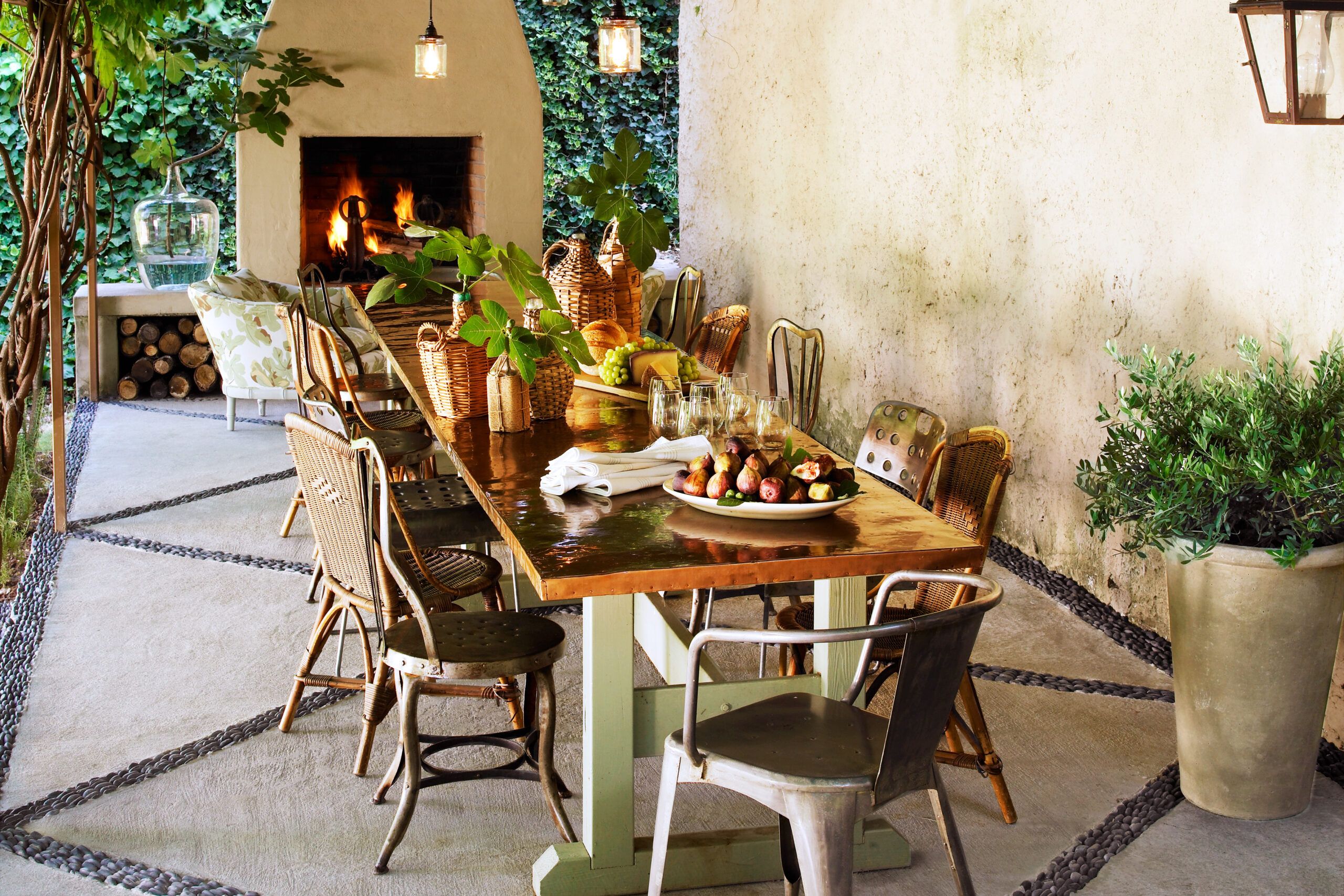
Create a living canopy to provide natural shade and shelter. Designer Heather Chadduck’s innovative approach uses a custom metal pergola entwined with wisteria to form a lush green roof. This design offers protection from sun and light rain while adding a romantic, garden-like atmosphere to the space. When selecting climbing plants, think about factors such as growth rate, maintenance requirements, and seasonal changes.
19. Pattern the Floor
Transform a plain concrete patio into a work of art by adding a graphic pattern. Use chalk lines to map out your design, then cut channels into the concrete using a specialized saw. Fill these channels with contrasting concrete, and embed river rocks for added texture. This technique creates a durable, low-maintenance floor that doubles as a decorative element in your outdoor room.
20. Add Warmth
A fireplace can serve as a stunning focal point and extend the usability of your space well into cooler seasons. Build a custom fireplace using cinder blocks lined with fireproof brick and finished with stucco for a polished look. Incorporate built-in seating walls or cubbies on either side to maximize functionality and create a cozy nook for enjoying cool evenings outdoors.
21. Favor a Free-Form Design
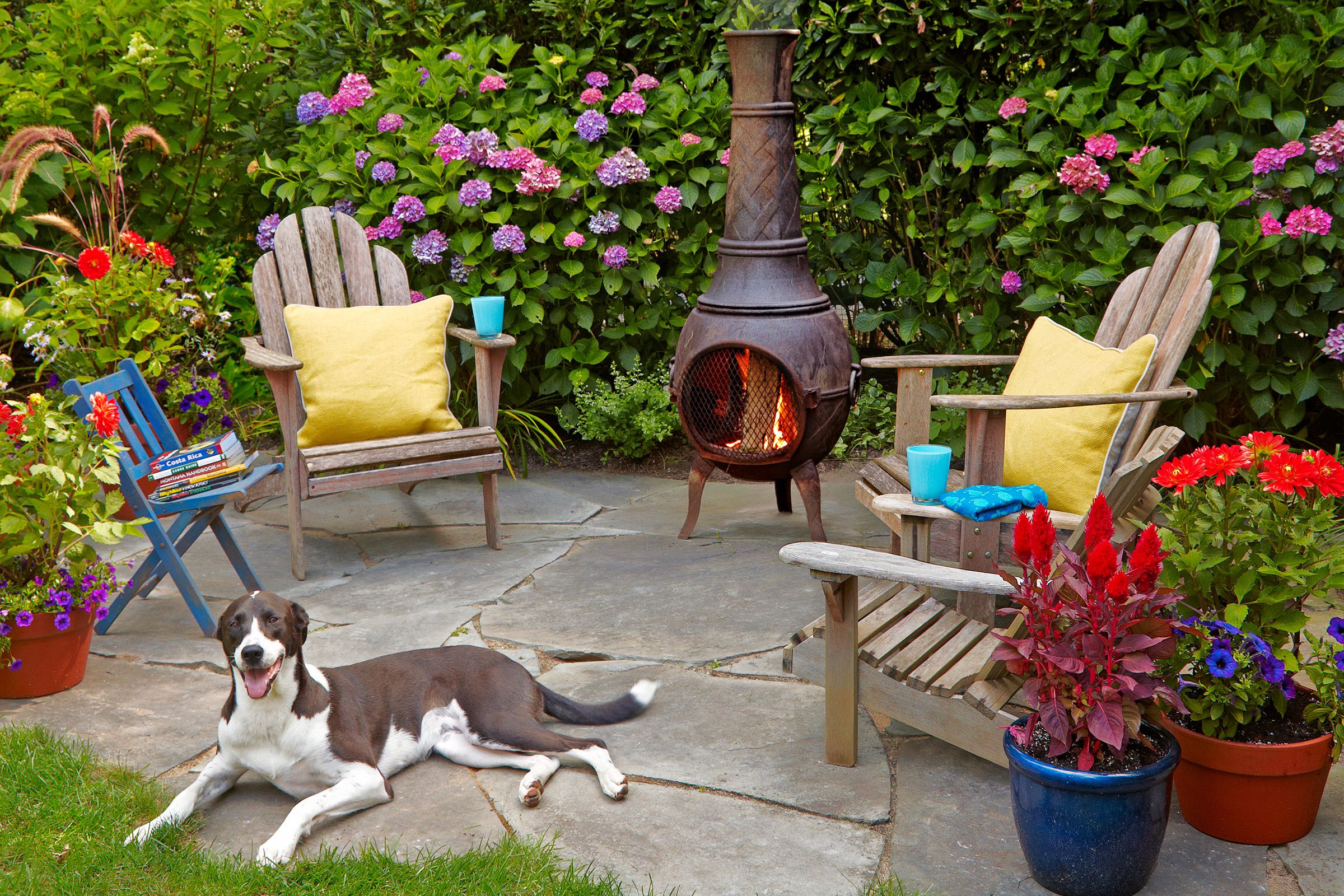
Embrace organic shapes in your outdoor space design to create a more natural, relaxed atmosphere. Architect Erica Broberg Smith demonstrates this approach with an irregularly shaped patio floor composed of various sizes of bluestone. Set in stone dust and bordered by turf, this free-form design complements the surrounding landscape and offers a more casual alternative to traditional rectangular patios.
22. Plant a Green Screen
Provide more privacy and create a lush backdrop for your outdoor room with strategically placed plantings. A layered approach using flowering shrubs in front of taller hedges can effectively screen unwanted views while adding visual interest and color to your space. Choose plants that thrive in your climate, and consider their mature size to ensure they’ll provide adequate coverage without outgrowing their intended space. A well-designed green screen can also muffle external noise and improve air quality.
23. Save With a Store-Bought Heater
For a more budget-friendly alternative to a built-in fireplace, use a portable chiminea or outdoor heater. A sturdy metal chiminea with a large mouth and safety screen can serve double duty as both a heat source and a spot for roasting marshmallows. Look for models with a removable grate to expand your outdoor cooking options.
24. Cozy Up to a Tree
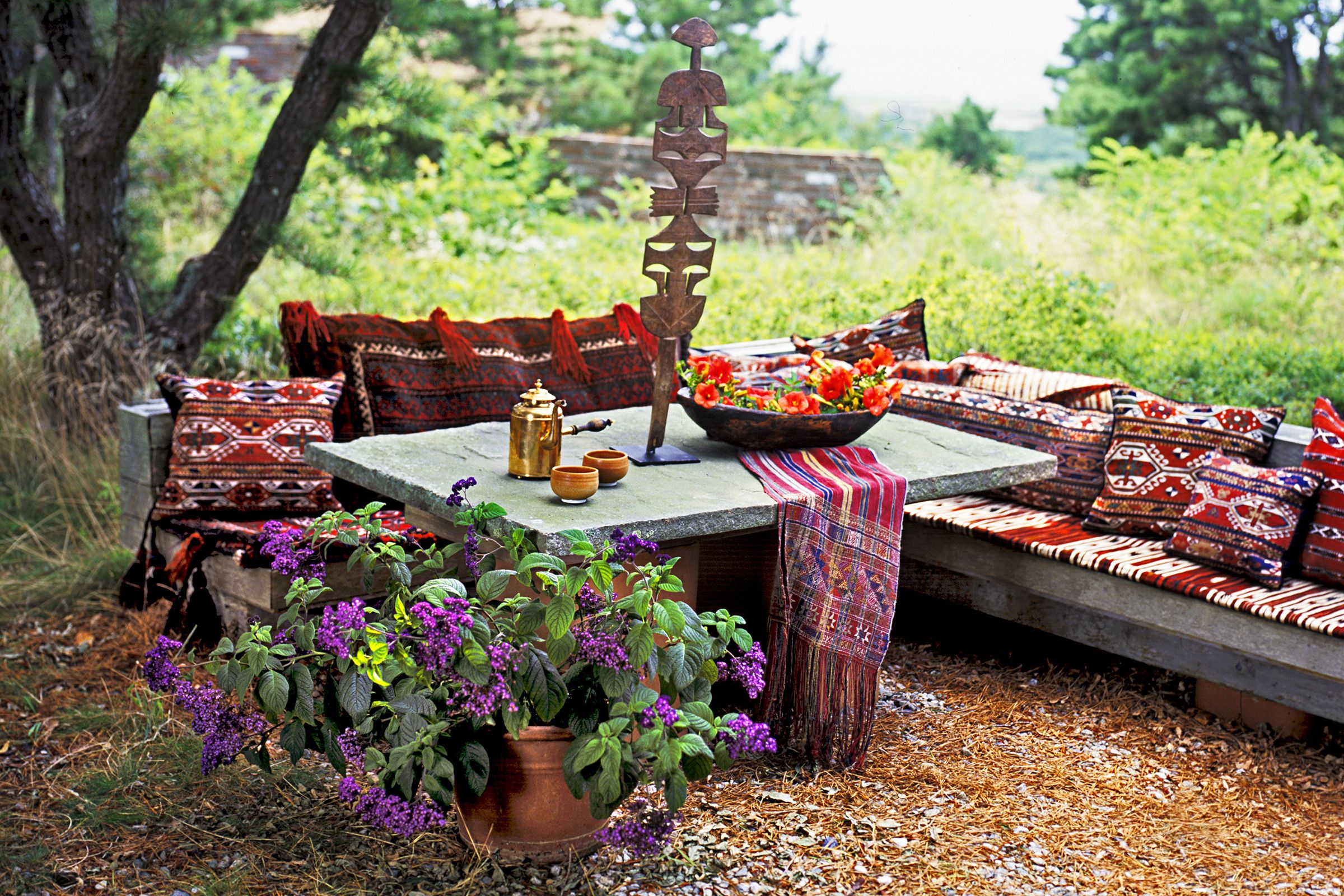
Incorporate existing landscape features, such as mature trees, into your outdoor room design. The overhanging branches of an established tree can provide natural shade, shelter, and a sense of intimacy. When building near trees, consult with an arborist to check that construction doesn’t damage the tree’s root system.
25. Install a DIY-Friendly Floor
Create a low-cost, natural-looking retreat by using pea gravel as flooring. Start with a base of crushed stone and stone dust, cover with landscape fabric, and then add a layer of pea gravel. This porous surface allows for proper drainage and requires minimal maintenance. Edge the area with pavers or larger stones to contain the gravel and create a defined border for your outdoor room.
26. Set Up a Flintstones-Inspired Table
For a rustic, organic look, use a thick slab of natural stone as a tabletop. Bluestone is an excellent choice for its durability and attractive coloration. When selecting a base, check that it’s sturdy enough to support the weight of the stone and proportionate to the slab size. A base height of no more than 26 inches and a diameter of at least two-thirds the length of the slab will provide stability and visual balance.
27. Establish a Perimeter With Benches
Use bench seating to define the boundaries of your outdoor gathering space. An L-shaped arrangement can provide banquette-style seating around a table, maximizing seating capacity in a compact area. Build custom cedar benches with built-in storage for a functional and stylish solution. Prefabricated all-weather benches from home improvement centers offer a quick and easy option for creating defined seating areas.
28. Erect a Thrifty Metal Wall
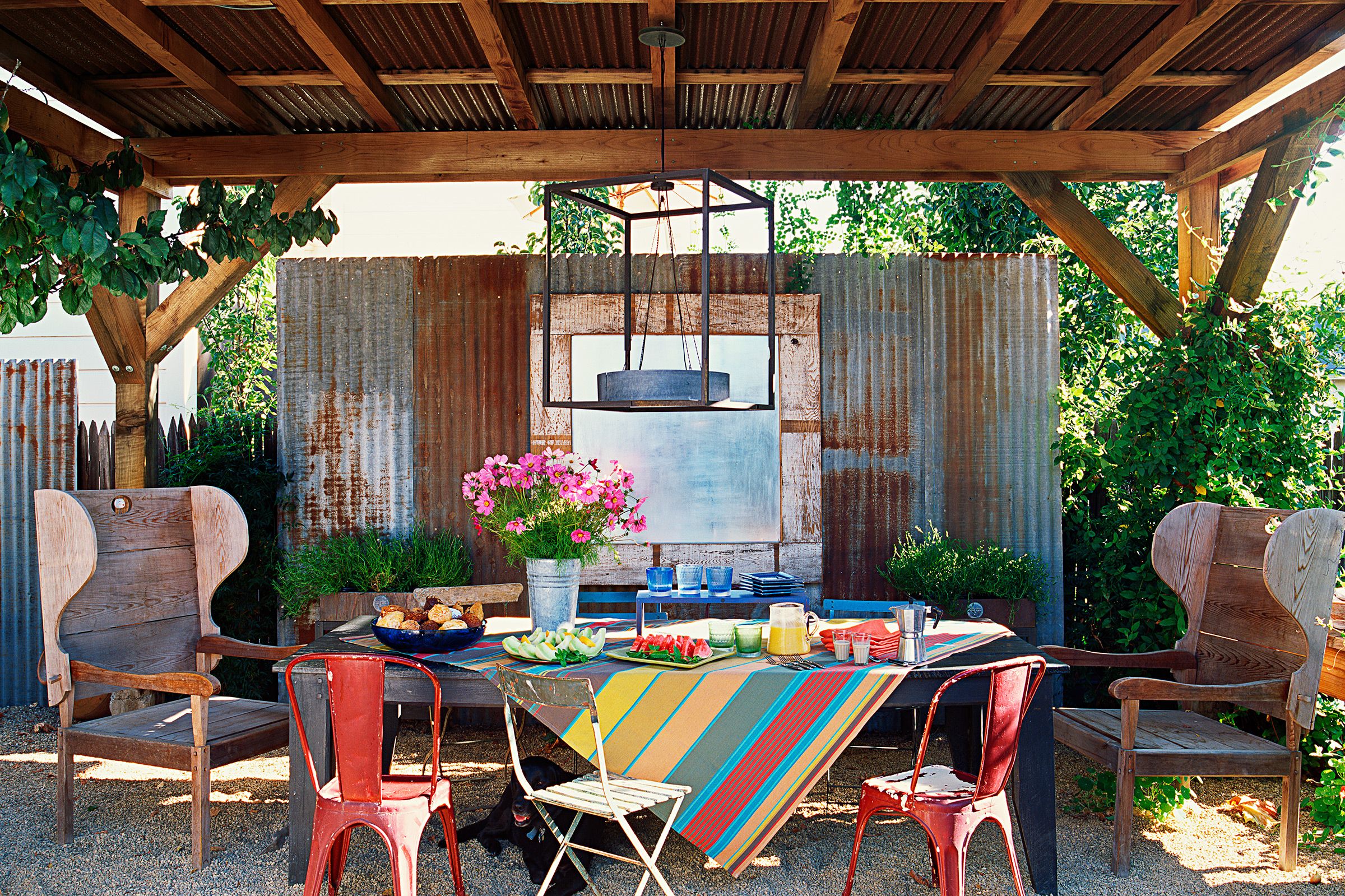
Transform humble materials into chic design elements by thinking creatively. Standing metal roofing panels on end and bolting them edge to edge creates an eye-catching wall with industrial flair. Extend this style to overhead structures by using similar panels to sheath the top of a pergola, creating a cohesive look that ties the entire space together.
29. Carve Out a Portal
Introduce a sense of depth and intrigue to your outdoor room by incorporating a “window” into a solid wall. Frame a sheet of acrylic with reclaimed wood planks to create a rustic-modern focal point that allows light to pass through. This technique can make a small space feel larger and more open. For a budget-friendly option, use wood from discarded shipping pallets and precut acrylic sheets from your local home improvement store.
30. Save Space With Shared Seating
Maximize seating capacity in your outdoor dining area by incorporating benches and settees instead of individual chairs. High-backed Shaker-style benches offer a striking visual element while allowing more guests to gather around the table. This approach is particularly effective for smaller spaces or when hosting larger gatherings.
31. Use Trees as a Design Element

Integrate existing trees into your outdoor room design for a seamless blend with nature. Instead of building a freestanding pergola, use sturdy tree trunks as natural supports for a slatted ceiling. This approach, demonstrated by designer Jamie Durie, creates a unique, organic structure that provides shade while preserving the trees’ natural beauty. You can use trees as supports to improve the natural integration of your outdoor structures.
32. Try a Step-Down
Create distinct zones within your outdoor living space by incorporating changes in level. A slight drop of just a few inches can help delineate different functional areas, such as separating a dining space from a larger deck. This subtle design feature adds visual interest and can make your outdoor room feel more spacious and well-defined.
33. Suspend a Pendant
Take advantage of overhead structures like pergolas or sturdy tree limbs to hang decorative lighting fixtures. A pendant light suspended over a dining table adds ambiance and functionality to your outdoor room. For the best lighting, position the fixture approximately 30 inches above the table surface. Choose weather-resistant materials and check for proper electrical installation for safety.
34. Build in Borders
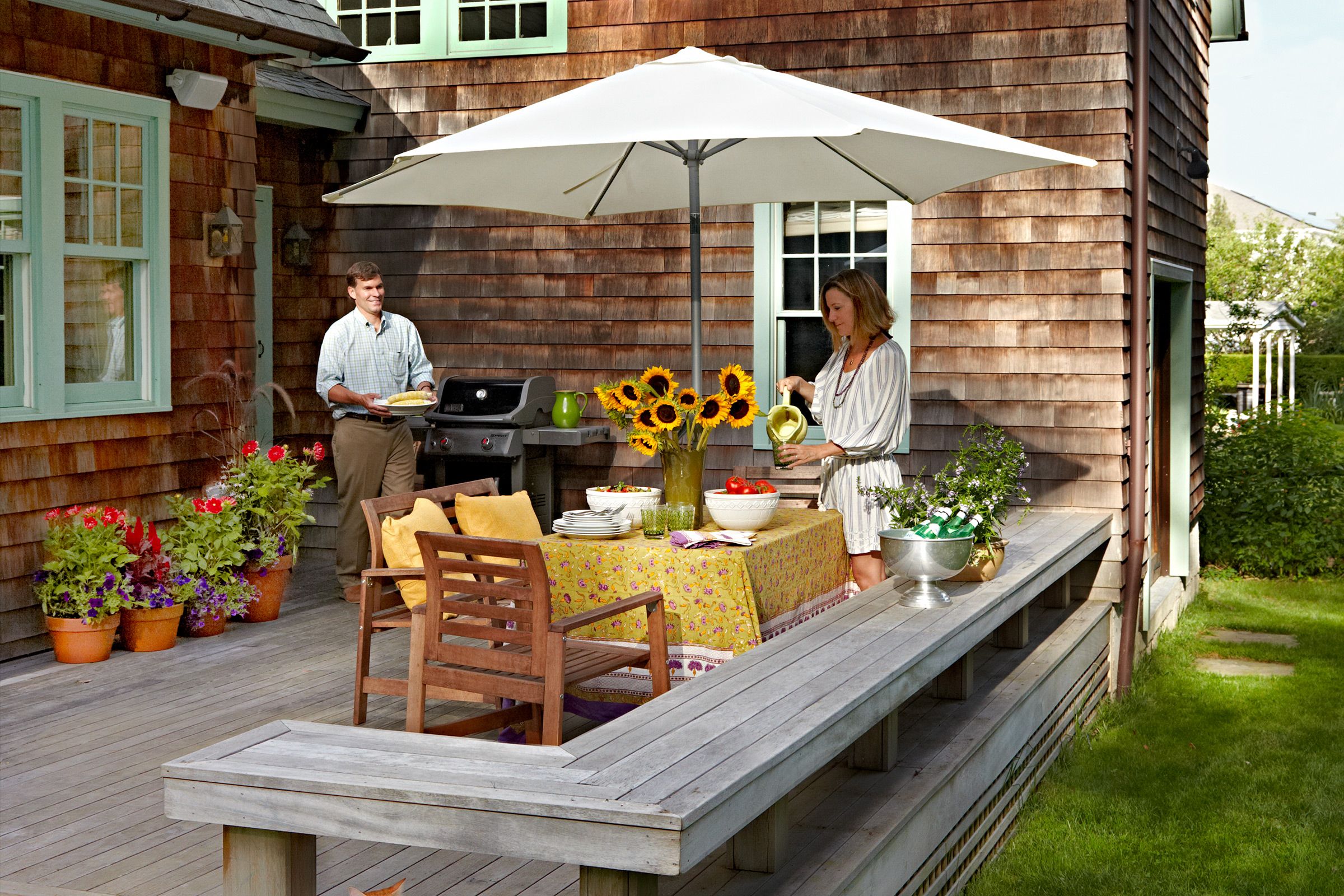
For low-level decks, incorporate built-in benches that double as safety railings. This multifunctional approach defines the space while providing ample seating without the need for additional furniture. Architect Erica Broberg Smith demonstrates this concept with a wide bench that offers enough space for lounging or sunbathing.
35. Add Some Tunes
Improve your outdoor entertainment setup with weather-resistant speakers. Choose between hardwired options that connect to your indoor stereo system or portable wireless speakers that sync with your smartphone or tablet. Strategically place speakers to provide even sound coverage throughout your outdoor room without disturbing neighbors.
36. Go for a Double-Duty Umbrella
Invest in a versatile patio umbrella that offers both daytime shade and evening illumination. Look for models equipped with built-in LED lights along the ribs or canopy edge. This dual-function feature eliminates the need for additional lighting fixtures and creates a warm, inviting atmosphere for nighttime gatherings. Double-duty umbrellas bring more usability and create a festive setting.
37. Create a Staging Area
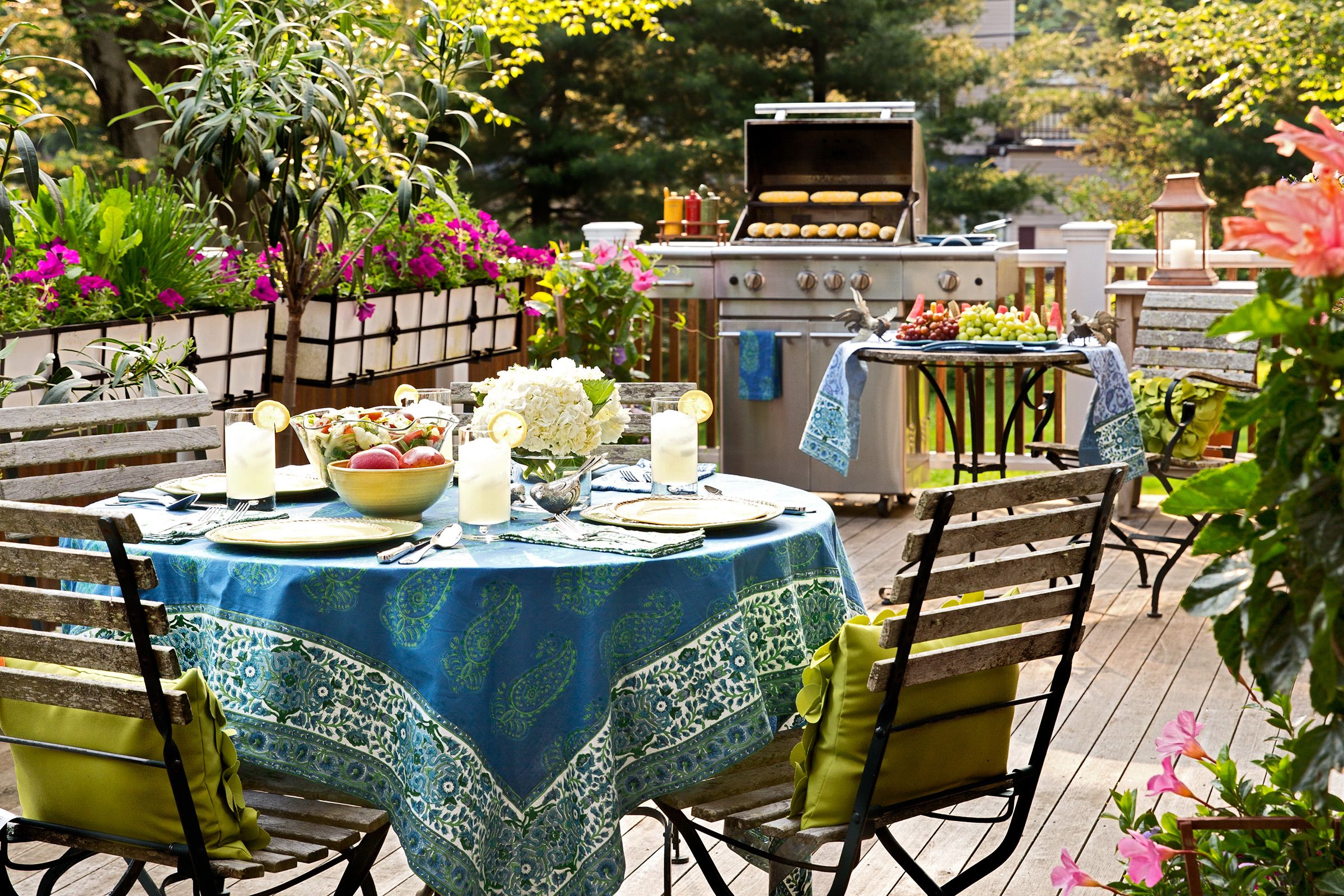
A small bistro table can serve as a staging area for ingredients, utensils, and serving platters, keeping everything within easy reach for the chef. This setup also provides an additional spot for guests to gather, making the cooking process more social and interactive. Staging areas streamline cooking and foster a communal cooking experience.
38. Make It Mobile
Opt for a barbecue grill on wheels to maximize flexibility in your outdoor kitchen. This addition allows you to easily reposition the grill to accommodate changing weather conditions or different event layouts. On smaller decks, a mobile grill setup enables the space to serve multiple functions, transitioning seamlessly from the cooking area to the lounging space as needed.
39. Add All-Around Interest
Incorporate railing planters filled with colorful flowers, ferns, or ornamental grasses to add visual interest and increase privacy in your outdoor room. Hanging planters on the inside of the railing means that you, rather than your neighbors, enjoy the full beauty of your plantings. This approach adds a lush, garden-like feel to elevated decks and porches.
40. Install a Tent-Like Topper
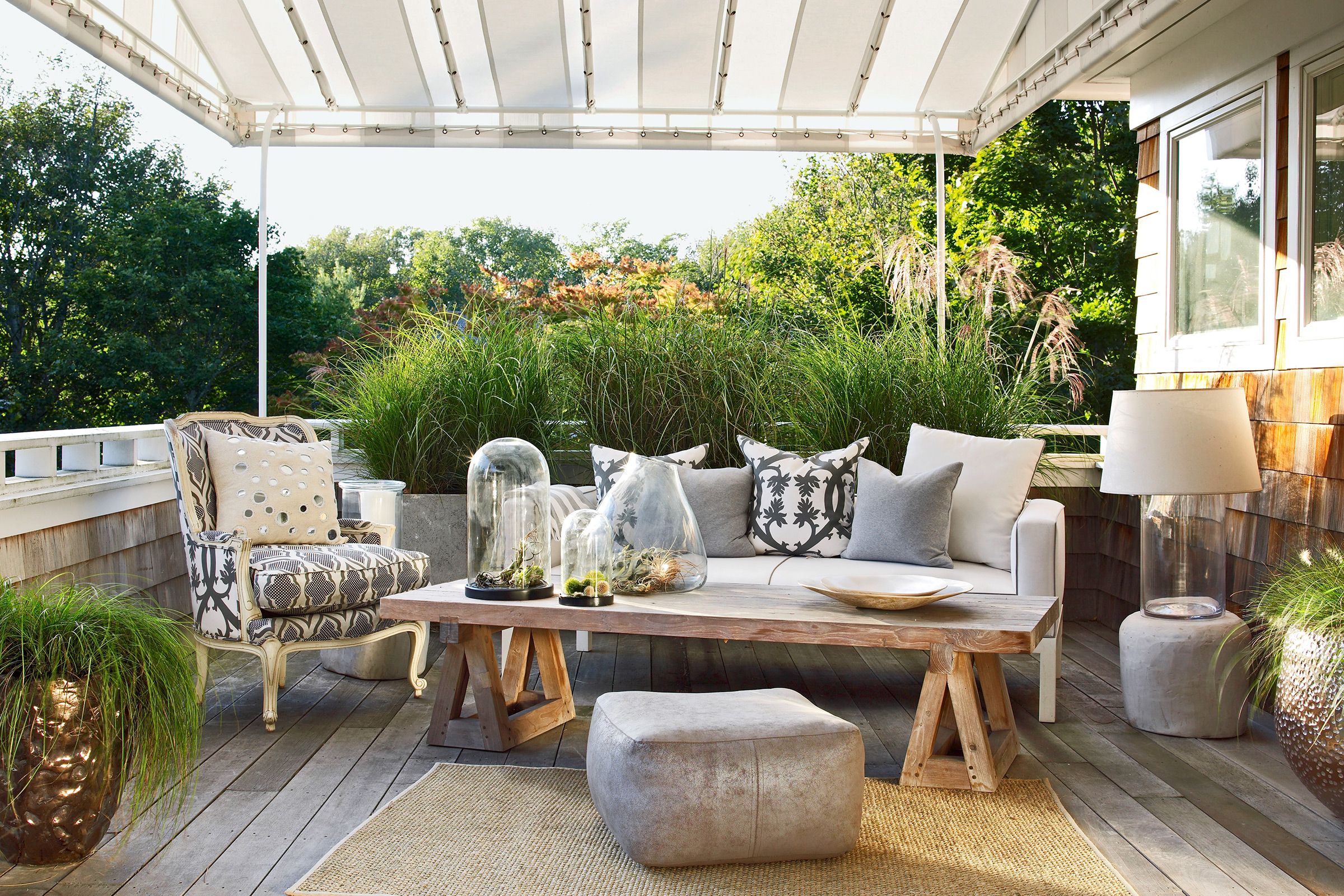
Create a stylish and affordable alternative to a solid roof with a fabric canopy. Use metal poles anchored to deck railings and the house to create a framework for fade-resistant fabric, or build a retractable version to enjoy full sun or starry nights as desired.
41. Make a Rustic Table
Create a cozy deck atmosphere with DIY furniture pieces made from natural materials. A coffee table with sawhorse-style legs adds rustic charm and can be customized to fit your space perfectly. Use reclaimed wood or locally sourced timber for an eco-friendly touch that adds character to your outdoor room.
42. Borrow Indoor Furnishings
Don’t hesitate to bring select indoor pieces outside to elevate your outdoor decor. Items like vintage wooden chairs, small bookshelves, or even colorful area rugs can add style and comfort to your outdoor gatherings. Just be sure to move them back inside once the party’s over.
